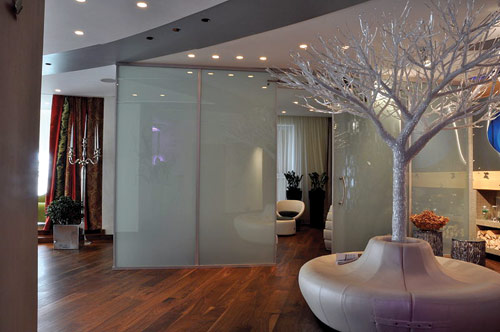Interior Sliding Frameless Glass Doors Make a Clear Contribution to LEED
Tempered glass design is also limited to clear or satin etching unless the project budget allows for an investment in a sophisticated new digital direct-to-glass printing technology that enables designs to be printed on glass quickly and permanently. That process begins with an image created by any current graphics design program. Once the electronic file is created, technicians match colors, scale the image, determine the proper panel layout, create printing files, and finally print edge-to-edge creative designs while permanently fusing the image into the glass. Images can be printed on glass panels up to 110 inches x 169 inches in thicknesses ranging from 3/16 inch to 1 inch.
Laminated glass. Currently regarded as “safety” glass, laminated glass consists of multiple (usually two) glass panels, each divided by a layer of PVB (polyvinyl butiral) and connected through high-temperature and high-pressure processes. In the event of glass breakage, the glass pieces are adhered to the PVB layer, making the site safer for passersby. One drawback is that if holes are drilled in the glass, the glass is weakened. Tempering the glass and then laminating it makes the glass both stronger and safer.
Laminated glass is a good choice in terms of increased acoustics and privacy through use of interior films including PVB, which is used for applications that require strong binding, optical clarity, and adhesion to many surfaces. The clear and clean glass facings offer a consistent finish that can be tempered with etching to change the panel's surface texture. Manufacturers offer a wide color range and designs can be printed on the film through elements in the glass such as tree leaves. Laminated glass also allows designers to use the switchable “intelligent” glass technology in which the glass finishes go from clear to opaque.
The Right Glass for Interior Sliding Doors
While many architects believe holes must be drilled to hold glass panels, this is a misconception. Many systems are available that do not require holes. The top-hung pressure clamps used by some European manufacturers hold glass doors up to 400 pounds without requiring holes in the glass. An alternative is ultra-strong double-face tape that allows the glass contractor to easily surface mount elegant handles. As a result, both tempered and laminated glass can be used in sliding doors, leaving the choice dependent upon the desired design.
There is also confusion in the industry in terms of the required glass thickness in commercial applications. The glass industry usually recommends ⅜-inch-thick glass for doors below 8 feet high and ½-inch-thick glass for doors between 8 and 10 feet high, in order to prevent bending of the glass in the taller panels. Although some glass contractors don't recommend panels over 10 feet high in commercial interiors, ⅝-inch- or ¾-inch-thick glass can be used successfully for taller panels. Standard widths are 3 feet and 42 inches for either fixed or sliding interior glass panes. The panel weights are calculated as follows:
- ⅜” glass with dimensions in inches (36” x 96” x ⅜”): (36” x 96”)/144) x 5 = 120 lb
- ⅜” glass with dimensions in feet (3' x 8' x ⅜”): 3' x 8' x 5 = 120 lb
- ½” glass with dimensions in inches (48” x 120” x ½”): (48” x 120”)/144) x 6.5 = 260 lb
- ½” glass with dimensions in feet (4' x 10' x ½”): 4' x 10' x 6.5 = 260 lb
Weight/square foot is 5 lb using ⅜” glass and 6.5 lb using ½” glass.
 |
 |
With switchable or “intelligent” glass technology, glass finishes go from clear to opaque. Photos courtesy of Shtiever |









